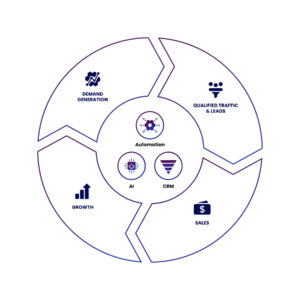In the rapidly evolving landscape of retail, the term “omnichannel” has emerged as a crucial strategy for businesses aiming to thrive in the digital age. With the convergence of online and offline shopping experiences, retailers are increasingly adopting omnichannel retail strategies to meet consumer expectations, enhance engagement, and boost profitability. This shift is not just a trend but a profound transformation that is reshaping the very foundations of modern commerce.
Understanding Omnichannel Retail
Omnichannel retail refers to a seamless integration of multiple shopping channels—physical stores, websites, mobile apps, social media, email, and more—to provide a unified and consistent customer experience. Unlike multichannel retail, where channels operate in silos, omnichannel strategies ensure that all touchpoints work together in harmony.
For instance, a customer might browse products on a retailer’s website, check reviews on social media, visit a physical store to see the product in person, and finally make the purchase through a mobile app. Throughout this journey, their preferences, history, and interactions are synced to deliver a personalized and frictionless experience.
Why Omnichannel Matters in Modern Commerce
1) Meeting Evolving Consumer Expectations
Modern consumers expect convenience, speed, and personalization. They want the freedom to shop anywhere, anytime, and through any device. Omnichannel strategies cater to these demands by offering consistent experiences across all platforms, thereby enhancing customer satisfaction and loyalty.
2) Enhanced Data Collection and Insights
By integrating all customer touchpoints, retailers gain comprehensive insights into customer behaviour, preferences, and buying patterns. This data is invaluable for tailoring marketing campaigns, optimizing inventory, and improving customer service—all of which are critical in modern commerce.
3) Improved Inventory Management
Omnichannel strategies allow for centralized inventory management. Retailers can fulfil orders from any location—be it a warehouse, a physical store, or a third-party vendor. This flexibility minimizes stockouts and overstock situations, leading to better efficiency and cost savings.
4) Increased Sales and Customer Retention
Consumers who engage with multiple channels are often more valuable than single-channel users. According to studies, omnichannel shoppers have a 30% higher lifetime value and are more likely to become repeat customers. This behaviour significantly contributes to long-term business growth in modern commerce.
Key Components of an Effective Omnichannel Strategy
1) Integrated Technology Stack
A robust technological foundation is essential. This includes POS systems, CRM software, inventory management tools, and analytics platforms that communicate with each other in real time.
2) Consistent Brand Messaging
Every channel should reflect a consistent brand voice and message. Whether a customer interacts with your brand via Instagram or walks into your store, the experience should feel cohesive.
3) Unified Customer Profiles
By consolidating customer data from all channels into a single profile, businesses can deliver hyper-personalized experiences that drive engagement and sales.
4) Flexible Fulfilment
Options like buy online, pick up in-store (BOPIS), curbside pickup, and same-day delivery provide the convenience that modern consumers crave. These fulfilment models are increasingly becoming standard in modern commerce.
5) Responsive Customer Service
Offering support across channels—live chat, email, phone, social media—ensures that customers can reach you when and how they prefer. Quick, helpful responses can turn a negative experience into a positive one.
Real-World Examples of Omnichannel Success
1) Nike
Nike has masterfully implemented an omnichannel strategy. Their app, website, and physical stores are interconnected, allowing customers to check product availability in real-time, schedule in-store pickups, and receive personalized recommendations. This integration has strengthened customer loyalty and significantly boosted sales.
2) Starbucks
Starbucks offers a seamless experience through its app, where customers can order ahead, earn rewards, and pay using their phones. This convenience has driven customer retention and enhanced overall satisfaction, proving the power of omnichannel in modern commerce.
3) Target
Target uses a unified approach to blend online and in-store shopping. Features like drive-up pickup, same-day delivery, and an intuitive app experience have made Target a leader in omnichannel retail.
Challenges in Implementing Omnichannel Strategies
1. Integration Complexities
Bringing together multiple systems and platforms requires significant technical expertise and investment. Poor integration can lead to inconsistent experiences and data silos.
2. Data Privacy Concerns
With increased data collection comes greater responsibility. Retailers must adhere to data protection regulations like GDPR and ensure robust cybersecurity measures.
3. Operational Overhaul
Transitioning to an omnichannel model often requires rethinking logistics, staffing, and workflows. It can be a complex process that needs careful planning and execution. Future Trends in Omnichannel and Modern Commerce
4. AI and Machine Learning
Artificial intelligence will play a bigger role in predicting customer behaviour, personalizing experiences, and automating tasks. AI-driven chatbots, for instance, can provide 24/7 customer service across all platforms.
5. Augmented Reality (AR)
AR is enhancing the online shopping experience by allowing customers to visualize products in real-world settings. This can reduce returns and boost confidence in online purchases.
6. Voice Commerce
As smart speakers become more popular, voice-enabled shopping will grow. Retailers need to adapt their content and platforms to be voice-search friendly.
7. Social Commerce
Platforms like Instagram, Facebook, and TikTok are evolving into shopping destinations. Integrating these platforms into your omnichannel strategy can tap into a vast audience.
Conclusion
Omnichannel retail strategies are not just an option; they are a necessity in the age of modern commerce. They empower businesses to meet the high expectations of today’s consumers, streamline operations, and gain a competitive edge. While the implementation can be complex, the benefits—enhanced customer experience, increased loyalty, and higher revenues—are well worth the investment.
As technology continues to evolve, so too will the capabilities and expectations surrounding omnichannel retail. Businesses that embrace this transformation today will be the leaders of modern commerce tomorrow.


